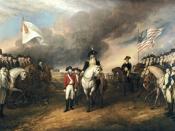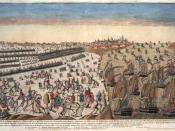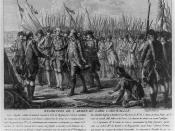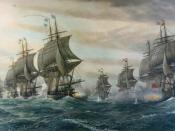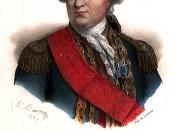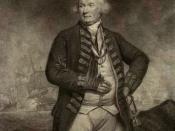In 1778, the war over the rebellion in North America became international spreading not only to Europe but to the European colonies chiefly in India. After learning of the American victory in Saratoga, France signed the Treaty of Alliance with the United States on February 6, 1778. Spain entered the war as an ally of France in June 1779; however, initially refused to recognize the independence of the United States. Spain was not keen on encouraging similar anti-colonial rebellions in the Spanish Empire. Both countries had quietly provided assistance to the Americans since the beginning of the war hoping to dilute British power. So too had the Netherlands, eventually brought into open war at the end of 1780.
In London, King George III gave up hope of subduing America by more armies while Britain had a European war to fight. The King was determined never to acknowledge the independence of the Americans, and to punish their contumacy by the indefinite prolongation of a war which promised to be eternal.
His plan was to keep the 30,000 men garrisoned in New York, Rhode Island, in Florida and Canada; other forces would attack the French and Spanish in the West Indies. To punish the Americans the King planned to destroy their coasting-trade, bombard their ports sack and burn towns along the coast and turn loose the Native Americans to attack civilians in frontier settlements. These operations, the King felt, would inspire the Loyalists and splinter Congress. This would also keep the rebels harassed, anxious, and poor, until the day when, they would beg to return to his authority. The plan meant destruction for the Loyalists and Native Americans and indefinite prolongation of a costly war, as well as the risk of disaster as the French and Spanish were assembling an armada to invade the British Isles and seize London. The British planned to re-subjugate the rebellious colonies after dealing with their European allies.
The Battle of the Chesapeake was a crucial naval battle in the American Revolutionary War which took place near the mouth of Chesapeake Bay between a British fleet led by Rear-Admiral Sir Thomas Graves and a French fleet led by Admiral Comte de Grasse. It was, in strategic terms, a major defeat for the Royal Navy.
The victory by the French fleet prevented the Royal Navy from resupplying the forces of General Lord Cornwallis at Yorktown. It also prevented interference with the supply of troops and provisions from New York to the armies of George Washington through Chesapeake Bay. As a result, Cornwallis surrendered his army after the Siege of Yorktown (the second British army to surrender during the war) and Great Britain later recognized the independence of the Colonies.
While his fleet of warships was sailing slowly towards the coast de Grasse had deliberately sent a message ahead to his colleague at Newport, Rhode Island Comte de Barras Saint-Laurent, stating weeks in advance his precise date of arrival. Barras forwarded this information to the generals Washington and Rochambeau, preparing to besiege New York and when they received it on August 14 they realized immediately the opportunity that de Grasse was presenting. Washington therefore prepared for a rapid march and requested Barras to take his small fleet south from Newport to the Chesapeake with the French artillery and other supplies that would be needed for a siege. De Grasse arrived at the Chesapeake on August 29 almost exactly on schedule, with a fleet that included 28 ships of the line and also carried three regiments of French troops under General Marquis de Saint-Simon, who were immediately disembarked to help the American troops under the Marquis de Lafayette keep Cornwallis from retreating inland. When the British fleet of 19 ships, now under Graves's command, arrived back at the Chesapeake on the morning of September 5, they found 25 French ships at anchor behind Cape Henry. The remaining ships of de Grasse's fleet had been detached to blockade the York and James Rivers farther up the bay, and many of the ships at anchor were missing officers, men, and boats.
With the wind and tide in their favor, as well as, the element of surprise in finding the French ships at anchor in a state of unpreparedness for battle, the British might have been able to inflict severe losses by sailing into the bay and striking quickly in a general attack. However, it is unlikely that such an idea ever occurred to Graves. Conventional naval tactics of the time called for the fleets to each form up in line of battle and then maneuver within gun shot range of each other, each ship attacking its opposite in the enemy line.
The French ships cut their anchors and sailed out of Chesapeake Bay to form their own line of battle. In order to engage each fleet would continue to maneuver the ships of the line for fighting purposes. It was over six hours since the two fleets had first sighted each other that they were ready to open their attack.
At this point both fleets were sailing generally east away from the bay. The two lines were approaching at an angle so that the leading ships of the vans of both lines were within range of each other. A shift in wind direction during the battle made it even harder for the ships in the British line to engage. Ships in the van on both sides were engaged in heavy and continuous firing from the beginning of the action, while several of the ships in the rear never got into action at all. There was also confusion in the British fleet's maneuvers caused by apparently contradictory signals issued by Graves during the battle.
Around 6:30 p.m., at dusk, firing ended. Graves gave a general signal to keep eastward so that the heads of the two fleets separated. By this time the British ships in the van division that had borne the brunt of the battle were very badly damaged and unable to continue to fight effectively in any case (the first five ships in the British line sustained over half of all British casualties). Many of the British ships had been leaking badly and were in need of refitting even before the battle and the French gunnery had been particularly destructive of the ships' rigging and masts.
The actual battle ended on the evening of September 5 but for several days afterwards the two fleets continued to maneuver within sight of each other as ships on both sides carried out repairs. In the meantime, both fleets were sailing farther and farther away from Chesapeake Bay, their strategic objective. Finally, in the night on September 9 de Grasse turned the French fleet around hoping that the French squadron from Newport, Rhode Island would have arrived in the Bay. When they arrived back at Cape Henry the following day they found that de Barras had indeed arrived after his carefully timed voyage bringing their combined strength to 36 ships of the line. Thus Chesapeake Bay was indisputably under French control and the artillery brought by de Barras was the key to the relatively short siege which followed at Yorktown.
Although the actual naval battle was inconclusive, the Battle of the Chesapeake was a major strategic victory for the French because of its consequences for the land campaign. Cornwallis was cut off from rescue or resupply while the French were reinforced by the troops brought by de Grasse and Washington's army converged from the north. This led to the siege of Yorktown, the surrender of Cornwallis' army, and the ultimate defeat of the British forces in America.
Mackesy, P. (1964). The War for America: 1775ÃÂ1783. London, Reprinted University of Nebraska Press, 1993
